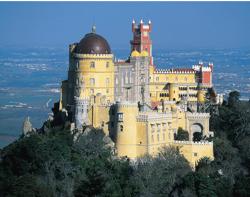

Sintra is one of those magical places where man and nature come together in a perfect symbiosis, as if wishing to leave us in a state leave of permanent surprise, enraptured by the beauty of their joint efforts. Declared a World Heritage Site by the UNESCO, it attracts thousands of visitors all year round, but there are always quiet spots among the wooded hills or the lush vegetation of its gardens. Essentially romantic in character Sintra was poetically described by Lord Byron as "this glorious Eden".
Known in ancient times as Mons Lunae (the Hills of the Moon), because of its strong traditions of astral cults, still clearly visible in the region's countless monuments and archaeological remains, the Serra de Sintra is a granite outcrop roughly 10 km long, rising abruptly between a vast plain to the north and the estuary of the River Tagus to the south. It is a mountain range that twists and turns, projecting into the Atlantic Ocean to form Cabo da Roca - the headland that marks the westernmost point of' continental Europe.
Cherished and revered over so many years, the Serra de Sintra today contains a fabulous collection of monuments from a whole host of different epochs, ranging from prehistoric times to the present day. This is a clear demonstration of the region's great respect for other people and its enormous cultural tolerance. Almost as important as the diversity of the monuments is the tremendous environmental wealth of the Serra. Thanks to its unique microclimate, Sintra has some of the most beautiful parks in Portugal, planted in keeping with a certain romantic taste, as well as a dense and verdant natural vegetation, affording the region an air of great majesty amidst the splash of different greens.
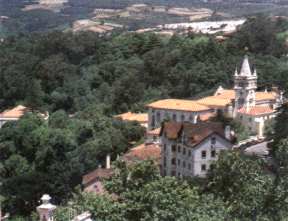
The visitor can therefore choose between descending into the Neolithic era at
Tholos do Monge; enjoying the view of the
distant horizons from the walls of the Castelo dos Mouros, an eighth-century Moorish defensive
construction; strolling through
the delightful mysteries of the Palácio da Pena,
a mythical and magical palace that seems more like a continuation of the actual
mountain; or savouring the nooks and crannies of the Parque da Pena, a place of love and exoticism that exudes great peace and
serenity.
In view of their ancient and heterogeneous quality, the group of buildings, at the small town Sintra, forming the region's so-called historical centre offers the visitor a fascinating trip into the human past, a chance to feel and admire the different ages that have provided so much history.
The town of Sintra still retains its essentially mediaeval layout, with
narrow and labyrinthine streets, steps and arcades. It is, however, dominated by
the Palácio Nacional, its main architectural feature and the most fascinating
regal construction in Portugal. This is a palace that was not created just once
nor in just one period, but instead is the result of a harmonious and seductive
assembly of different parks, built in successive phases and in a variety of
styles. And it is these multiple tastes and mentalities that have - largely
contributed to the strange beauty of this palace. Amongst its different phases
of building work, perhaps the most notable are the two great periods that gave
the palace both its shape and character: the one led by D. João I in the first
third of the fifteenth century and then, a century later, in the first quarter
of the sixteenth century, the one that took place in the reign of D. Manuel I.
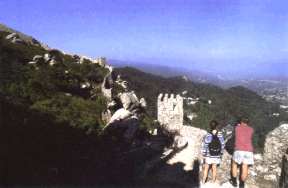
The palace has been the setting for countless important events in national
history. It was here that D. Afonso V was born and died; D. João II was
proclaimed king; D. Manuel I received the news of the discoveries of India and
Brazil; D. Sebastião departed to fight the ill-fated battle of Alcácer Quibir;
and the unfortunate D. Afonso VI was so sadly imprisoned. This palace was the
preferred residence for royal leisure-seekers, simultaneously serving as a
centre for their recreation and learning. Inside the palace, the bucolic poet
Bernardim Ribeiro could be seen strolling regularly through its rooms, whilst
the playwright Gil Vicente performed here, João de Barros engaged in his
writings, and Camões probably read his Lusíadas to D. Sebastião for the first
time. Amidst the palace's labyrinthine and surprising co11ection of rooms,
courtyards, staircases, corridors and galleries, one of the most notable
features is what amounts to the largest and richest set of Mudéjar azulejos to
be found in the Iberian Peninsula. In view of the peculiarly peninsular quality
of this type of ceramic covering, this is equivalent to saying the richest and
largest collection of such tiles in the world. Visitors will feel as though they
have entered a Moorish palace, the kind of which fairy tales are made. They will
stare in wonder at the ceiling of the Sala dos Cisnes (Swans' Room), which
reminds us of the marriage of the InFanta D. lsabel of Portugal to Philip the
Good, Duke of Burgundy, marvel at the somewhat malicious revival of mediaeval
legends in the Sala das Pêgas (Magpie or Reading Room), and gasp in admiration
at the fantastic Sala dos Brasões (Armoury), its glorious ceiling decorated
with the coats of arms of the Portuguese nobility and its floor worn away by the
continuous striding back and forth of D. Afonso VI, incarcerated in this room
for the last nine years of his life. And, as they leave the palace, they cannot
fail to cast one last admiring glance from the inside at the huge conical
chimneys of the monks' kitchen, the best known and defining landmark of the town
of Sintra.
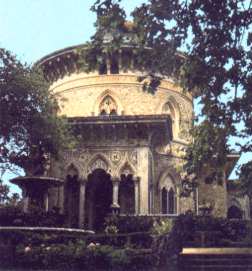
The historical centre does, however, contain other monuments of great dignity
and interest that should also be admired: the Torre do Relógio (clock tower),
Igreja de São Martinho, Paço dos Ribafria, Convento da Trindade, Igreja de
Santa Maria, a remarkable series of ancestral fountains, such as the Fonte da
Pipa and the Fonte da Sabuga. And it is also worth paying an attentive visit to
the Jewish quarter, a group of houses inhabited by the followers of the Laws of
Muses.
On the outskirts of the town are some of most beautiful and important creations of the Romantic movement. At the top of the Serra stands the nineteenth-century Palácio da Pena, the delightful product of the dreams of an artist king, D. Fernando, whilst at the foot of the mountains magnificent chalets are to be found scattered here and there, as well as small palaces such as the neo Oriental Monserrate, surrounded by its exuberant and exotic park and constituting a genuine botanical museum, and large stately homes, such as the Quinta do Relógio, with its neo-Moorish palace, or the Quinta da Regaleira, carrying us back to the world of initiatory symbols. All this is finally, a brilliant revivalist cycle that completely transformed the Sintra landscape in a most remarkable and seductive fashion.
In I924, a sophisticated casino was built 1924 with all the delightful atmosphere created by Art Nouveau for the entertainment and enjoyment of the elite of the recently-formed Republican bourgeoisie. This remained a great tourist attraction in Sintra until it disappeared in 1938. Today, the beautiful building of the former casino houses a magnificent collection of contemporary art.
For all these reasons, plus the freshness of the region's pure air, the mists of its indescribable mystery and its vibrant culture, the great variety of its organised events Sintra is still very much as it was once described by Robert Southey: ''the most blessed place in the whole of the inhabitable world''.
Monastery dos Capuchos
|
Experiencing the harsh austerity of the Franciscan monks of the Convento dos Capuchos. This little monastery, constructed amid the rocks of Sintra in fulfilment of a vow by Dom Álvaro de Castro (1560), its cells and dependencies lined with cork, is a wonderful example of Christian austerity in its simplicity of decoration and meagre materials and space. The little chapel, the refectory, the living quarters, almost
troglodyte in dimension, are cut into the crags, and underline the
intention of meditation inherent in the project. In the chapel are to be
noted the altar with inlay work, some 17th Century frescos by André
Reinoso and an 18th Century frontispiece of azulejos, the last named in
the outer chapel. |
|
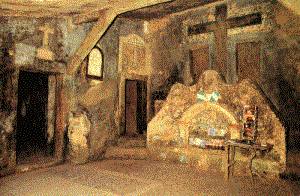 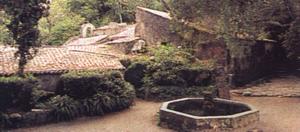 |